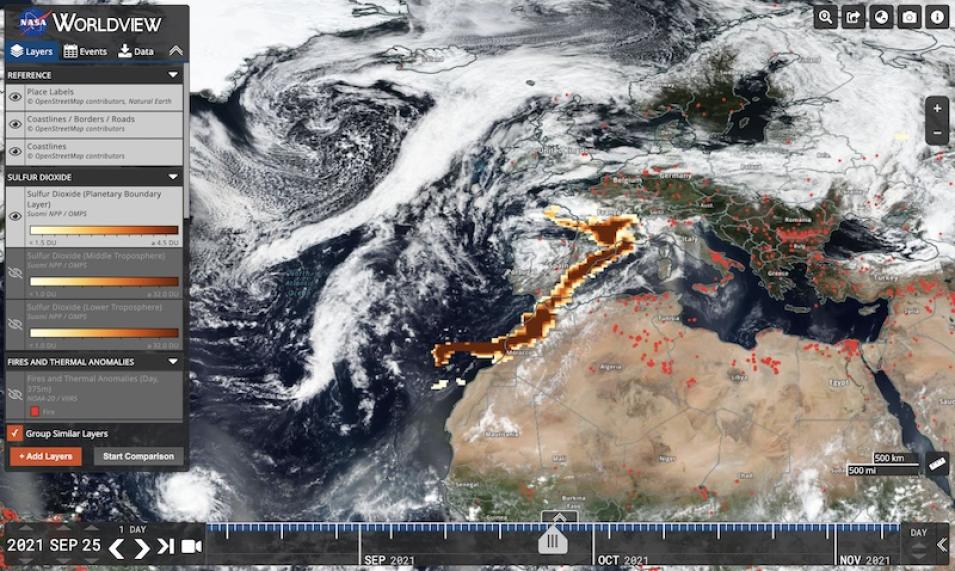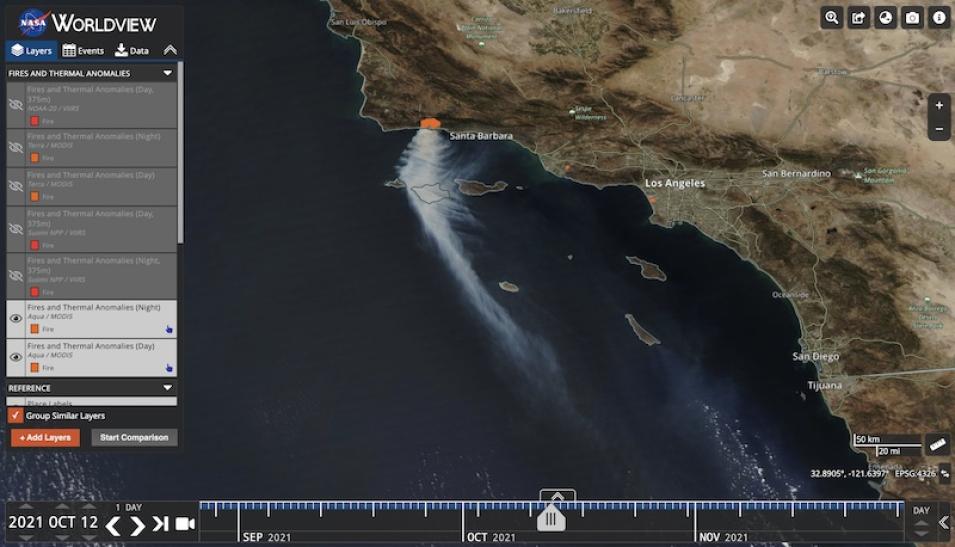- Aerosol Index
Aerosols absorb and scatter incoming sunlight, which reduces visibility and increases the optical depth. Aerosols have an effect on human health, weather and the climate. Sources of aerosols include pollution from factories, smoke from fires, dust from dust storms, sea salts, and volcanic ash and smog. Aerosols compromise human health when inhaled by people with asthma or other respiratory illnesses. Aerosols also have an affect on the weather and climate by cooling or warming the earth, helping or preventing clouds from forming.
Satellite-derived Aerosol Index (AI) products are useful for identifying and tracking the long-range transport of volcanic ash from volcanic eruptions, smoke from wildfires or biomass burning events and dust from desert dust storms, even tracking over clouds and areas of snow and ice.
| Product: Instrument (Platform) and Download Link | Description | Browse imagery in Worldview |
| OMI (Aura) OMAERUV | The Ozone Monitoring Instrument (OMI) Aerosol Index (AI) indicates the presence of ultraviolet (UV)-absorbing particles in the air (aerosols) such as desert dust and soot particles in the atmosphere. The sensor resolution is 25 km, imagery resolution is 2 km, and the temporal resolution is daily. L2 Near UV Aerosol Optical Depth and Single Scattering Albedo Swath 13x24 km. | |
| OMPS (Suomi NPP) NMMIEAI-L2-NRT | The Ozone Mapping and Profiler Suite (OMPS) Aerosol Index (AI) indicates the presence of UV-absorbing particles in the air (aerosols) such as desert dust and soot particles in the atmosphere. The unitless range of the AI is from 0.00 to >=5.00, where 5.0 indicates heavy concentrations of aerosols that could reduce visibility or impact human health and this satisfies the needs of most users. However, the AI signal for pyrocumulonimbus (pyroCb) events, which are both dense and high in the atmosphere, can be much larger than 5.0. To provide better near real-time imagery for these high AI events, the pyroCb product has an upper AI limit of 50.0. The sensor resolution is 50 km, imagery resolution is 2 km, and the temporal resolution is daily. OMPS-NPP L2 NM Aerosol Index swath orbital NRT | |
- Aerosol Optical Depth
Aerosol Optical Depth (AOD) (or Aerosol Optical Thickness) indicates the level at which particles in the air (aerosols) prevent light from traveling through the atmosphere. Aerosols scatter and absorb incoming sunlight, which reduces visibility. From an observer on the ground, an AOD of less than 0.1 is “clean” - characteristic of clear blue sky, bright sun and maximum visibility. As AOD increases to 0.5, 1.0, and greater than 3.0, aerosols become so dense that sun is obscured. Sources of aerosols include pollution from factories, smoke from fires, dust from dust storms, sea salt, and volcanic ash and smog. Aerosols compromise human health when inhaled by people, particularly those with asthma or other respiratory illnesses. Aerosols also have an effect on the weather and climate by cooling or warming the earth, helping or preventing clouds from forming. Since aerosols are difficult to identify when they occur over different types of land surfaces and ocean surfaces, Worldview provides several different types of imagery layers to assist in the identification.
- Corrected Reflectance Imagery
MODIS and VIIRS Corrected Reflectance imagery are available only as near real-time imagery. The imagery can be visualized in Worldview and Global Imagery Browse Services (GIBS).
More:
Information on MODIS Corrected Reflectance Imagery layers including
- Corrected Reflectance True Color (Bands 1-4-3)
- Corrected Reflectance (Bands 3-6-7)
- Corrected Reflectance (Bands 7-2-1)
Information on VIIRS Corrected Reflectance Imagery layers including
- Corrected Reflectance True Color (Bands I1-M4-M3)
- Corrected Reflectance (Bands M3-I3-M11)
- Corrected Reflectance (Bands M11-I2-I1)
Browse Corrected Reflectance imagery in Worldview
For more on the difference between Corrected Reflectance and Surface Reflectance Imagery
- Fire
The VIIRS and MODIS Fire and Thermal Anomalies layer shows active fire detections and thermal anomalies, such as volcanoes, and gas flares. Fires can be set naturally, such as by lightning, or by humans, whether intentionally or accidentally. Fire is often thought of as a menace and detriment to life, but in some ecosystems it is necessary to maintain the equilibrium, for example, some plants only release seeds under high temperatures that can only be achieved by fire, fires can also clear undergrowth and brush to help restore forests to good health, humans use fire in slash and burn agriculture, to clear away last year’s crop stubble and provide nutrients for the soil and to clear areas for pasture. The fire layer is useful for studying the spatial and temporal distribution of fire, to locate persistent hot spots such as volcanoes and gas flares, to locate the source of air pollution from smoke that may have adverse human health impacts.
- Land Surface Reflectance
In comparison with the MODIS Corrected Reflectance product, the MODIS Land Atmospherically Corrected Surface Reflectance product (MOD09) is a more complete atmospheric correction algorithm that includes aerosol correction, and is designed to derive land surface properties.
| Product: Instrument, Platform and Download Link | Description | Browse imagery in Worldview |
MODIS (Aqua) MYD09
MODIS (Terra) MOD09
| doi:10.5067/MODIS/MYD09.NRT.061 (Aqua) and doi:10.5067/MODIS/MOD09.NRT.061 (Terra) More information on MODIS Land Surface Reflectance Products including: - MODIS (Aqua/Terra) Land Surface Reflectance True Color (Bands 1-4-3)
- MODIS (Aqua/Terra) Land Surface Reflectance True Color (Bands 7-2-1)
- MODIS (Aqua/Terra) Land Surface Reflectance True Color (Bands 1-2-1)
| |
VIIRS (Suomi NPP)
VNP09_NRT | VIIRS Land Surface Reflectance
The VIIRS Surface Reflectance provides continuity with the EOS-MODIS Land Surface Reflectance product.The Suomi NPP/VIIRS surface reflectance products are estimates of surface reflectance in each of the VIIRS reflective bands I1-I3, M1-M5, M7, M8, M10, and M11. Surface reflectance for each moderate-resolution (750m) or imagery-resolution (375m) pixel is retrieved separately for the Level-2 products and is obtained by adjusting top-of-atmosphere reflectance to compensate for atmospheric effects. Corrections are made for the effects of molecular gases, including ozone and water vapor, and for the effects of atmospheric aerosols. The inputs to the surface reflectance algorithm include top-of-atmosphere reflectance for the VIIRS visible bands (VNP02MOD, VNP02IMG), the VIIRS cloud mask and aerosol product (NPP-CMIP_L2), aerosol optical thickness (NPP_VAOTIP_L2, NPP_VAMIP_L2), and atmospheric data obtained from a reanalysis (surface pressure, atmospheric precipitable water, and ozone concentration). All surface reflectance products are produced for daytime conditions only. | Coming soon |
- Sulfur Dioxide
Sulfur Dioxide (SO2), is a colorless gas with a pungent, suffocating odor that is water soluble to produce the acid, H2SO3. SO2 is one of the US Environmental Protection Agency's (EPA) six major regulated criteria pollutants (Tropospheric Ozone [O3], Nitrogen dioxide [NO2], Sulfur dioxide, Lead, PM2.5 and PM10 particulates). It irritates the eyes, nose, and lungs. High concentrations of SO2 can result in temporary breathing impairment. It is produced by combustion of coal, fuel oil, and gasoline, since these fuels contain sulfur in the combustion, and in the oxidation of naturally occurring sulfur gases. It is a precursor to sulfuric acid, which is a major constituent of acid rain. SO2 is injected into the stratosphere by volcanic eruptions. SO2 also is a major precursor to PM2.5 (Particulate Matter up to 2.5 micrometers in size), which is a significant health concern, and a main contributor to poor visibility. These data are used by the Volcanic Ash Advisory Centers in advisories to airlines for operational decisions.
| Product: Instrument (Platform) and Download Link | Description | Browse imagery in Worldview |
AIRS (Aqua)
AIRIBRAD_NRT.005 | The AIRS Prata SO2 Index Day/Night layer indicates Sulfur Dioxide column amounts in the atmosphere, measured in Dobson Units (DU); it is science parameter is a derived parameter from the Level 1B Near-Real Time Infrared (IR) geolocated and calibrated radiances, (AIRIBRAD_NRT). The imagery resolution is 2 km and sensor resolution is 45 km. The temporal resolution is daily. L1B IR geolocated radiances | Sulfur Dioxide (Day/Night Prata Algorithm) |
MLS (Aura)
ML2SO2_NRT.005
| The MLS Sulfur Dioxide (SO2) Mixing Ratio layer at 147hPa (hectopascals) indicates sulfur dioxide levels at the vertical atmospheric pressure level of 147hPa, and is measured in parts per billion by volume (ppbv). The sensor resolution is 5 km, imagery resolution is 2 km and the temporal resolution is twice daily (day and night). MLS/Aura NRT L2 SO2 Mixing Ratio | Sulfur Dioxide (147 hPa, Day/Night) |
OMI (Aura)
OMSO2NRTb | The OMI Sulfur Dioxide (SO2) Lower Troposphere layer indicates the column density of sulfur dioxide in the lower troposphere (corresponding to 2.5 km center of mass altitude (CMA)) and is measured in Dobson Units (DU). Sulfur Dioxide and Aerosol Index products are used to monitor volcanic clouds and detect pre-eruptive volcanic degassing globally. L2 Sulfur Dioxide (SO2) Total Column Swath 13x24 km SO2 Planetary Boundary Layer Measures the tropospheric boundary-layer component of the total SO2 column measured in Dobson Units (DU). SO2 Lower Troposphere Indicates the column density of SO2 in the lower troposphere (corresponding to 2.5 km center of mass altitude (CMA)). SO2 Middle Troposphere Indicates the column density of sulfur dioxide in the middle troposphere (corresponding to 7.5 km center of mass altitude (CMA)). SO2 Upper Troposphere and Stratosphere layer Indicates the column density of sulfur dioxide in the upper troposphere and stratosphere (corresponding to 17 km center of mass altitude (CMA)) and is measured in Dobson Units (DU). | |
OMPS (Suomi NPP) NMSO2-PCA-L2-NRT | OMPS NRT products complement the sulfur dioxide NRT data already available from OMI
OMPS/Suomi NPP PCA SO2 Total Column 1-Orbit L2 Swath 50x50km NRT | |


